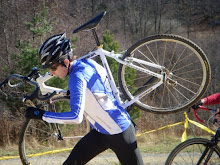It reminded me of a scarf that a former girlfriend used to wear. I have seen scarves like it before and found myself thinking about the kind of girls that wear them. They usually seem to be artistic or musical with a well defined personal style. However, I usually see them worn as a fashion statement not for warmth.
When I interviewed her about the scarf I found that it was a gift from a former roommate, and former friend. A girl Jenna lived with during the Fall 2006 semester had lent it to her and when it was to be returned told Jenna to keep it. Jenna's roommate liked Jenna but not Jenna's sister and it is suspected that the gift of the scarf was potentially intended to upset the sister. While most of this story remains a mystery to me I feel that it would be better left that way. I asked Jenna if she thinks about this when she decides to wear the scarf and she told me she did. Sometimes it upsets her to think about it but usually it is not an issue. Regardless of the somewhat unusual story surrounding the acquisition of the scarf Jenna likes the sweater very much commenting that it is very soft and warm. She says the color can be difficult to match because of how bold it is but that it is a good color and it reflects her fashion sense.
